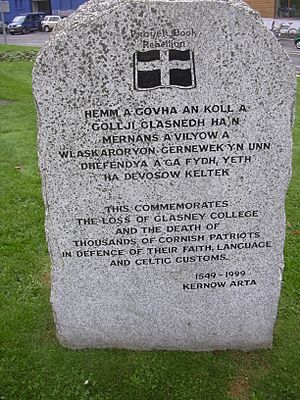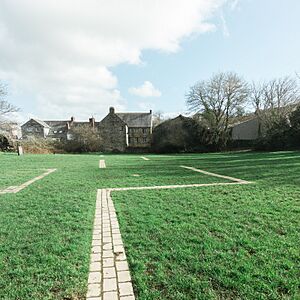Glasney College facts for kids
Glasney College (Cornish: Kolji Glasneth) was a very important religious building founded in 1265. It was located in Penryn, Cornwall, England. Bishop Bronescombe started it. Glasney College was a major center of church power in medieval Cornwall. It was probably the most famous and important religious place in Cornwall.

Contents
History of Glasney College
Glasney College was built at the start of a small creek. Many parts of the building looked like Exeter Cathedral. To protect the college and the town of Penryn, Bishop Bronescombe built three towers. These towers formed a strong block for defense.
After it was founded in 1265, Glasney College became the largest church group in Cornwall during the Middle Ages. It was as big as any old monastery and had a similar income. This money mainly came from the tithes (a type of tax) from many parishes like Budock, Mylor, and St Gluvias.
Glasney College did not have monks. Instead, it had a provost (a leader) and 12 secular canons (priests who were not monks). They also had control over 16 parishes. William Bodrugan was the first official Provost of Glasney, starting in 1283.
Plays in Cornish Language
Special plays called Miracle plays were performed at Glasney College. These plays were in the Cornish language. Only a few Cornish plays from that time still exist today. Some of the most famous ones were written at Glasney. These include the Ordinalia, which tells stories like The Creation of the World and The Resurrection of Our Lord. Another important play was Bewnans Meriasek, which was about the life of St Meriasek.
Destruction of Glasney College
King Henry VIII decided to close down many religious places in England between 1536 and 1545. This was called the dissolution of the monasteries. Many big Cornish priories (religious houses) were closed then. Glasney College was a special kind of church called a chantry church. It managed to survive until 1548, but then it was also destroyed.
The destruction of Glasney College and another college at Crantock was a big loss. It ended the formal learning that helped keep the Cornish language and culture strong. This destruction also made many people in Cornwall very angry. It was a major reason for the Prayer Book Rebellion in 1549. The large granite stones from Glasney College were later used to build King Henry VIII's fort at Pendennis Castle.
Many people in Cornwall felt that these colleges were important links to their Celtic past. They connected them to their ancestors and their traditions.
The Prayer Book Rebellion
In 1548, traditional religious parades and journeys were stopped. Officials were sent to destroy all symbols of the old Roman Catholic faith in Cornwall. William Body was one of these officials. His actions, like damaging religious shrines, upset many people. Along with other changes to Cornish laws, culture, language, and religion, this led to his murder on April 5, 1548, in Helston.
Legacy of Glasney College
Today, not much of Glasney College remains. You can still see a part of a wall and an arch. In 1986, a group called the Friends of Glasney College Society was started in Penryn. Dr James Whetter helped create this group. In his book, The History of Glasney College, he says that the destruction of Glasney was a very harmful event for the history and spirit of the Cornish people.
Modern Memorials
At the Penryn Campus of Falmouth University and the University of Exeter, there is student housing. This housing has been named Glasney Student Village. It is divided into two parts called Glasney View and Glasney Parc.


